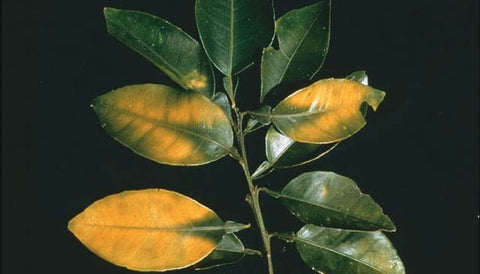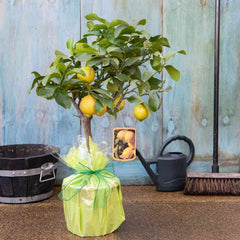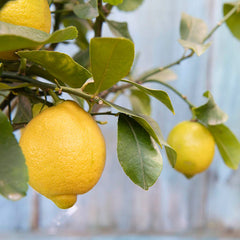Lemon trees are cherished across the world for their bright, yellow zesty fruits and extremely fragrant blossom, they thrive in warm, temperate locations and grow well in areas of the Mediterranean.
Lemon varieties are not hardy in the UK, but that doesn’t mean we can’t grow them over here. They can be grown outdoors in the summer when the weather is warm (June- early Sept, above 18C) and then brought back indoors for the cold, winter months.
Keep reading our lemon tree care guide for top tips on how to care for your lemon tree in the UK.
How to care for Lemon Trees
Taking great care of your lemon trees will ensure copious rewards. The fragrant flowers can bloom throughout the year and the fruits can ripen in any season.
Main issues with citrus trees:
- Over or under-watering
- Dramatic temperature changes
- Not getting enough light and nutrients
So where should you keep your lemon tree?
Location is everything when it comes to taking care of your tree. Lemon trees thrive in bright, well-ventilated spaces away from any central heating and cold drafts. Unheated conservatories and hallways are all perfect locations.
Your tree will need a good amount of sunlight a day, put your tree in a location that gets at least 6 hours of good filtered sunlight a day. Especially when it starts to produce fruits. The more sun your lemon tree gets the larger the fruits will be.
Lemon trees are very sensitive to frost and although lemon sorbet is a tasty treat make sure to put your tree in an area where it is protected from any cold snaps and frosty weather.
How to water your Lemon Tree
With a proper watering schedule, your lemon tree will thrive. Properly caring for your tree includes incorporating a combination of watering and feeding techniques. Lemon trees require watering regularly. If your tree is starting to lose its flowers, leaves or unripe fruit then the soil is too dry.
The most common mistake when caring for lemons trees is over and under-watering. Citrus plants will not tolerate having “wet feet” so avoid leaving sitting in water and ensure that the compost has excellent drainage.
Under-watering is also an issue, check your lemon tree every few days and when the top of the soil starts to feel dry to the touch then it’s time to give it some water. Give your tree a good soak and allow all the excess water to drain away before putting it back.
How to Feed Lemon Trees
Just as watering is important for lemon trees, so is feeding it. There are certain nutrients that lemon trees need that are essential for them to thrive, without these nutrients, the leaves will change to various different colours—telltale signs that your plant is starved for iron, magnesium or nitrogen.
Summer Lemon Tree Feed
Feeding your tree in the summer can be done weekly from April to September with our summer citrus feed. It is a high nitrogen fertiliser to support the growth of healthy new foliage and prevents the developing fruits from prematurely ripening.
Winter Lemon Tree Feed
Feed your tree monthly in the winter from October to March. Our winter citrus feed gives your tree a steady supply of nutrients throughout the colder months to maintain balanced growth and help prevent leaf drop and discolouration.
As citrus fruit trees can flower and fruit in any season it’s important to give them balanced nutrients throughout the whole year. We offer a full year supply in our annual citrus tree feed so you can keep your lemon tree healthy and happy all the way through the year. Simply follow the feed packet instructions.
Lemon Tree with an Iron Deficiency

When the space between a leaves veins begins to yellow, leaving the veined green, the plant is thought to be suffering from interveinal chlorosis, or an iron deficiency. When this happens to a lemon tree, it can be remedied by increasing the plant’s iron intake. Commonly, a lemon tree iron deficiency is treated with chelates, sprayed directly onto the leaves. That is an example of leaves with choloris.
Magnesium Deficiency in Citrus Leaves

Leaves that are yellowing in the centre, with a green tip and a green V-shaped base are indicative of a magnesium deficiency. If the deficiency is acute, the leaves will drop from the plant. Use a plant food rich in magnesium to fix this issue.
Lemon Plant with a Nitrogen Deficiency

When a lemon tree is devoid of enough nitrogen to sustain it, its leaves become mottled with yellow before turning completely yellow and falling off of the tree. The yellowing of mature leaves is a sign of nitrogen deficiency. In the image shown, the dark green leaf is normal while the other two are symptomatic of a tree deficient in nitrogen.
Why is my lemon tree dropping leaves?
Anyone who has looked after a lemon tree will know about the dreaded citrus leaf drop. While it looks quite alarming, it’s usually just your tree trying to tell you something is wrong. You can read our full guide on citrus leaf drop on our blog but read some helpful hints below.
How to Fix Lemon Leaf Drop
Like we said, if your lemon tree starts dropping its leaves then this means it is feeling stressed and something isn’t right. Check the following things below and your lemon tree will bounce right back and start growing new leaves.
- Is your tree experiencing dramatic temperature changes?
When placed near central heating or a cold draft the rapid changes in temperature can cause stress to your tree. Place away from radiators and open windows. - Is your tree over or under-watered?
If your tree is too dry you may notice that the leaves are turning crispy and falling, if too wet the leaves may start to go limp and curl before falling. - Is your tree getting enough light?
Lemon trees do need a lot of light to flourish, aim for bright indirect sunlight for around 6 hours a day.
Common Lemon Tree Pests
All plants suffer from pests and the lemon tree is no different. With its nutrient-rich leaves and fruit, it attracts a myriad of creepy crawlers, anxious to destroy your plant. There are three common lemon tree pests to be aware of: sucking insects, gall wasps and the citrus leaf miner.
Sucking insects such as aphids or mealybugs create a black discolouration on leaves that they come into contact with. Aphids can simply be hosed off of the plant while a gentle insecticide is recommended for mealy bugs.
The goal of the gall wasp would be to make itself at home in your lemon tree. They lay their eggs in the plant’s stems and branches, causing them to swell and become lumpy. You will need to remove these lumpy bits before the insect's hatch.
Finally, the citrus leaf miner leaves a calling card of distorted leaves with silvery trails. Because citrus leaf miners live inside the leaf, it is best to treat them by cutting away the affected areas.
Many things that can go wrong in a garden, from injuries from tools to crops not producing fruit, but there’s no reason that your lemon tree should suffer. If you are aware of the things we discussed and follow our tips for treating nutrient deficient or pest-ridden plants, you will see your lemon tree thrive and produce stunning fruit, perfect for slicing into a glass of something cold and refreshing or incorporating into an alfresco dinner.
Send a Lemon Tree as a Unique Gift
If you have a friend or family member with a special occasion coming up soon why not send them a Lemon Tree Gift? We have a wide variety of shapes and sizes from our Mini Lemon Tree to our Espalier Lemon Tree.
Discover more from our range of citrus tree gifts, simply add to basket, personalise a greetings card and select a delivery date of your choice.
Images courtesy of the University of Florida's Agricultural Electronic Data Information Source.



